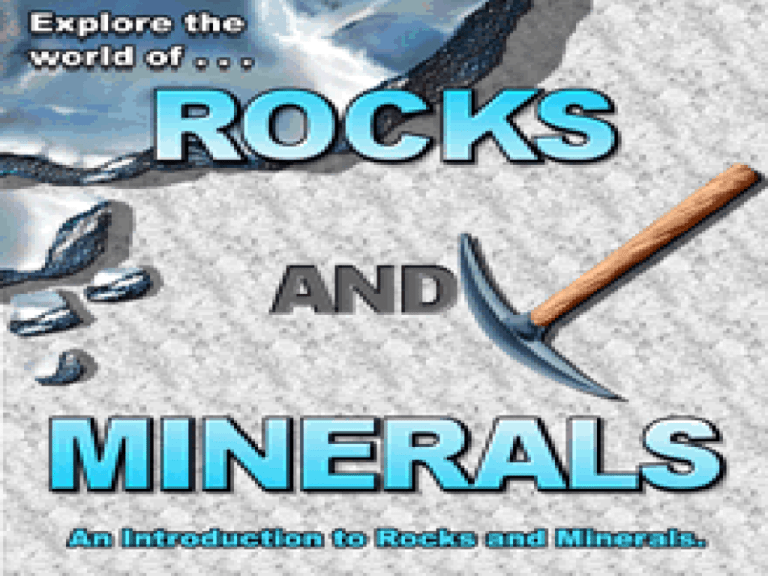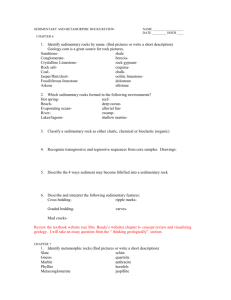Rocks and Minerals 3 Sedimentary
advertisement

Sedimentary Rock • Sedimentary rock is rock that is formed from the accumulation and consolidation of sediments (weathered particles of other rocks). • Lithification is the process by which sediments become rock. – Ex: sandstone, shale, conglomerate Compression Compression occurs as the pressure created by water and overlying sediments becomes great enough to force particles of sediment close together, drive out any water, and compact the sediments into rock. A good example is shale. Shales Cementation Cementation occurs as the addition of minerals, such as silica, lime, or iron oxide, tends to “glue” rock particles together to form solid rock. Examples are sandstone and conglomerate, which are composed of particles of sand, pebbles and small rocks. Sedimentary Rocks Conglomerate Sandstone Formation by Chemical Process Some sedimentary rocks form as the result of chemical processes such as evaporation and precipitation. Rocks formed by the evaporation of water are called evaporites. Examples are limestone, rock salt and rock gypsum. Examples of Sedimentary Rocks Formed by Chemical Processes Formation by Biological Processes • Some sedimentary rocks form as a result of processes acting on the remains of once living organisms. • Coal is formed from the compression of dead plants. • Limestone is formed from the remaining shells of dead sea-life. Fossils Sedimentary rocks also form and contain remains or impressions of plants and animals. These impressions are called fossils. Fossils More Fossils 3 Kinds of Sedimentary Rocks Clastic sedimentary rocks form from the compaction and cementation of fragments of other rocks. Chemical sedimentary rocks form from mineral grains that precipitate out by evaporation or other chemical action. Organic sedimentary rocks form from the remains of plants and animals. Properties of Sedimentary Rocks Rocks may have one or all of these properties at the same time: • Discrete layers • Fragmental particles • Organic composition • Range of particle sizes, or – Predominance of one particle size. Sedimentary Samples Metamorphic Rock • Any kind of rock can become a metamorphic rock. • Metamorphic rock is rock produced by morphism – Morphism means to change, so these rocks are formed by the transformation of preexisting rocks into distinct new rocks. • Metamorphic rocks form as a result of the recrystalization of unmelted material under conditions of extremely high temperature and pressure over long periods of time. Classification of Metamorphic Rocks Texture refers to the appearance and mineral arrangement of metamorphic rocks. Foliated rocks have minerals that pressure has aligned into layers that are easy to split. Banding occurs when there are thin layers of alternating minerals. Metamorphic rocks are in many ways similar to their parent material. How Does Morphism Occur? Metamorphic rocks form as a result of: – High temperatures – High pressures – Combination of both –BUT without the rock melting in the process. Types of Metamorphism Contact Metamorphism occurs when molten rock comes in contact with surrounding rocks. The heat from the magma alters the rock in contact with it. Regional Metamorphism accounts for the greatest amount of metamorphism and occurs when large areas of rock are under intense heat and pressure. Metamorphism Metamorphic Rocks Metamorphic Rocks What is the Rock Cycle? • The rock cycle is a theory relating to various rock forming processes of the common rock types The Rock Cycle Rock Cycle Transition Zones • The process that creates a transition zone between rock type is contact metamorphism







